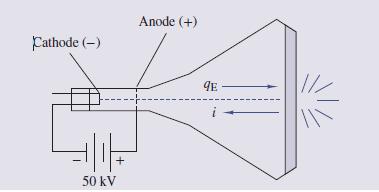For nearly a century, visual displays of alternating signals on televisions, oscilloscopes, radar screens, and so on
Question:
For nearly a century, visual displays of alternating signals on televisions, oscilloscopes, radar screens, and so on were seen using a cathode ray tube or CRT. In Europe, it was called the Braun tube named after its German inventor Ferdinand Braun in 1897. However, it was J. J. Thomson, an English physicist, who was able to show how to deflect cathode rays, a fundamental function of the modern CRT.
In its basic operation, an electron beamis produced from a heated filament connected to a negative voltage called the cathode. These energized electrons are then accelerated by a positive voltage, placed at a screen called the anode that is located some distance away inside an evacuated container, usually made of glass, called a vacuum tube. These electrons pass through the anode and strike a phosphorescent screen exciting the phosphor and producing light at the spot they strike. Another voltage placed across the neck of the CRT can cause the beam to be deflected in proportion to the signal applied, thereby allowing the signal to be visualized. Today, scanned beams are still used for ion implantation in the manufacture of integrated circuits.
Consider the simplified diagram of a CRT shown in Figure 1–1. If the electron beam carries 1014 electrons per second and is accelerated by a voltage of 50 kV, find the power in the beam.

Step by Step Answer:

The Analysis And Design Of Linear Circuits
ISBN: 9781119235385
8th Edition
Authors: Roland E. Thomas, Albert J. Rosa, Gregory J. Toussaint





